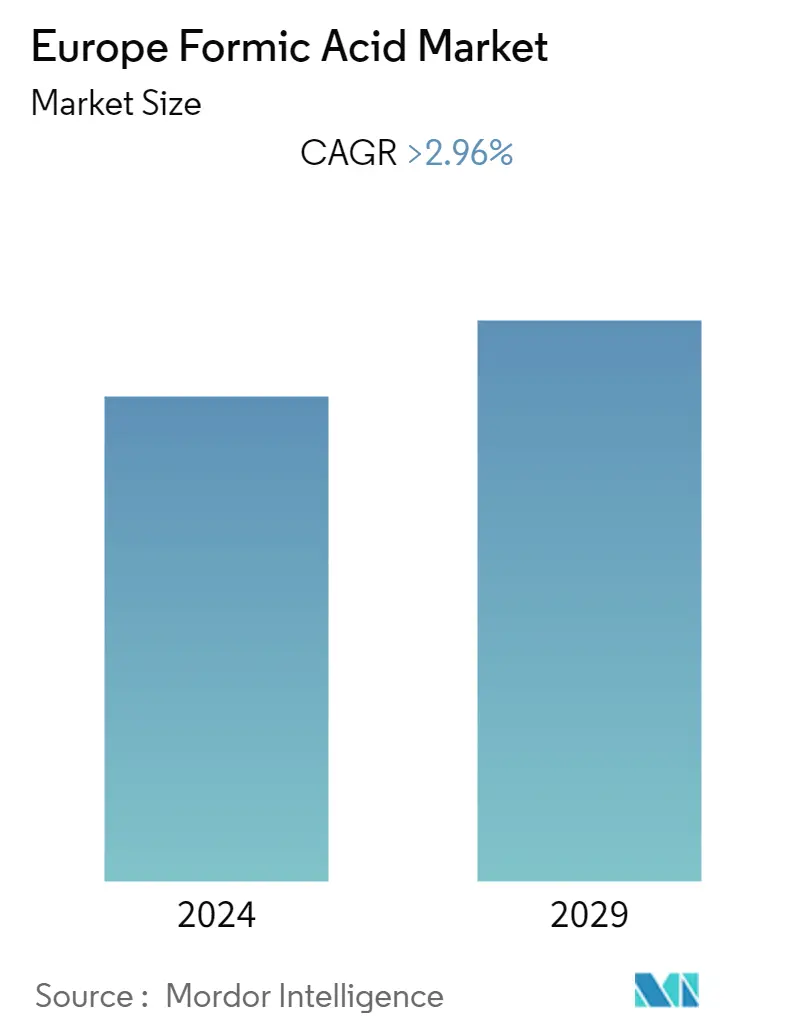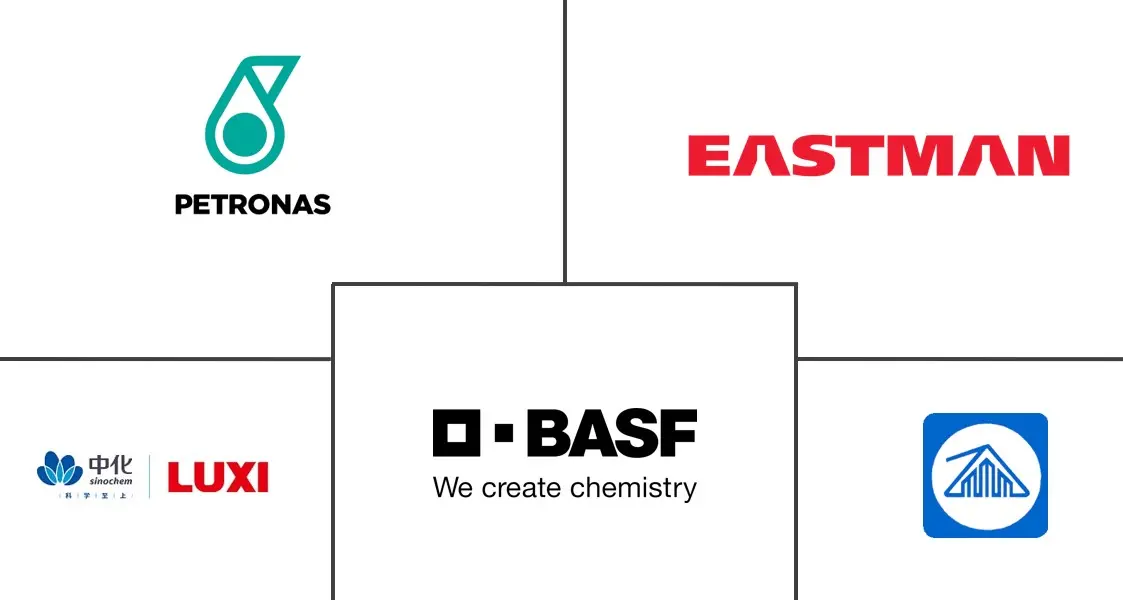Market Size of Europe Formic Acid Industry

| Study Period | 2019 - 2029 |
| Base Year For Estimation | 2023 |
| Forecast Data Period | 2024 - 2029 |
| Historical Data Period | 2019 - 2022 |
| CAGR | > 2.96 % |
| Market Concentration | High |
Major Players
*Disclaimer: Major Players sorted in no particular order |
Europe Formic Acid Market Analysis
The Europe Formic Acid Market is estimated to reach 290.34 kilotons by the end of this year and is projected to reach 335.87 kilotons in the next five years, registering a CAGR of over 2.96% during the forecast period.
Due to the COVID-19 outbreak, demand from several segments of formic acid, like animal feed and silage additives and pharmaceutical intermediaries, remained firm. However, a drop in demand was observed from the leather tanning and textile and finishing segments owing to the curbs induced on social gatherings, which led to the limited purchase of these products. However, the demand recovered substantially with the reopening of European economies in 2021.
- One of the major drivers for formic acid is the consistent increase in the demand for animal feed and silage additives. It is owing to the rising concerns about animal health and nutrition.
- However, growing emphasis on substitutes like urea sulfate in applications like leather tanning is restraining the market growth.
- Using formic acid as a sustainable alternative in fuel cells will likely create opportunities for the market studied in the European region in the coming years.
- Germany is expected to dominate the European formic acid market since it contains the largest industrial base in the region.
Europe Formic Acid Industry Segmentation
Formic acid, or methanoic acid, is the simplest form of carboxylic acid with a pungent odor. Due to its antibacterial and preservative properties, it is used in the animal feed and silage industry as an additive and an intermediary in the pharmaceutical industry. The product is also used in other industries like leather, tanning, dyes, and textiles.
The Europe Formic Acid Market is segmented by application and geography. The product is segmented by application into animal feed and silage additives, leather tanning, textile dyeing, finishing, an intermediary in pharmaceuticals, and other applications (cleaner, cosmetics, etc.). The report also covers the market size and forecasts for the formic acid market across 5 countries in the European region. The market sizing and forecasts are provided in volume (tons) for each segment.
| Application | |
| Animal Feed and Silage Additives | |
| Leather Tanning | |
| Textile Dying and Finishing | |
| Intermediary in Pharmaceuticals | |
| Other Applications (Cleaners, Cosmetics, etc.) |
| Geography | |
| Germany | |
| United Kingdom | |
| Italy | |
| France | |
| Spain | |
| Rest of Europe |
Europe Formic Acid Market Size Summary
The European formic acid market is experiencing a steady growth trajectory, driven by its diverse applications across various industries. The demand for formic acid is notably bolstered by its use as an additive in animal feed and silage, where it serves as a preservative and antibacterial agent, addressing the rising concerns over animal health and nutrition. The compound feed industry in Europe, with its significant production capacity, plays a crucial role in this demand. However, challenges such as animal diseases and geopolitical tensions, like the Russia-Ukraine war, have disrupted production and posed challenges to market growth. Despite these hurdles, the market is poised for expansion, with Germany leading due to its robust industrial base and significant contributions to the pharmaceutical and textile sectors.
Germany's prominence in the European formic acid market is further reinforced by its strong pharmaceutical industry, which is the largest in Europe. The country's investments in vaccine production and pharmaceutical manufacturing are expected to drive the demand for formic acid, used in the synthesis of various pharmaceutical drugs. Additionally, the textile industry in Germany, despite facing supply chain disruptions, continues to show resilience with a focus on sustainable production. The consolidation of the market is evident with major players like BASF SE and Eastman Chemical Company, alongside strategic acquisitions such as Petroliam Nasional Berhad's acquisition of Perstop, enhancing their foothold in the specialty chemicals sector. These dynamics indicate a promising outlook for the formic acid market in Europe, with Germany at the forefront of this growth.
Europe Formic Acid Market Size - Table of Contents
-
1. MARKET DYNAMICS
-
1.1 Market Drivers
-
1.1.1 Growing Demand for Animal Feed and Silage Additives
-
1.1.2 Increasing Usage in Leather Tanning Industry
-
1.1.3 Other Drivers
-
-
1.2 Market Restraints
-
1.2.1 Presence of Alternatives like Urea Sulfate
-
1.2.2 Other Restraints
-
-
1.3 Industry Value Chain Analysis
-
1.4 Porter's Five Forces Analysis
-
1.4.1 Bargaining Power of Suppliers
-
1.4.2 Bargaining Power of Buyers
-
1.4.3 Threat of New Entrants
-
1.4.4 Threat of Substitute Products
-
1.4.5 Degree of Competition
-
-
-
2. MARKET SEGMENTATION (Market Size in Volume)
-
2.1 Application
-
2.1.1 Animal Feed and Silage Additives
-
2.1.2 Leather Tanning
-
2.1.3 Textile Dying and Finishing
-
2.1.4 Intermediary in Pharmaceuticals
-
2.1.5 Other Applications (Cleaners, Cosmetics, etc.)
-
-
2.2 Geography
-
2.2.1 Germany
-
2.2.2 United Kingdom
-
2.2.3 Italy
-
2.2.4 France
-
2.2.5 Spain
-
2.2.6 Rest of Europe
-
-
Europe Formic Acid Market Size FAQs
What is the current Europe Formic Acid Market size?
The Europe Formic Acid Market is projected to register a CAGR of greater than 2.96% during the forecast period (2024-2029)
Who are the key players in Europe Formic Acid Market?
BASF SE, Eastman Chemical Company, LUXI GROUP, Petroliam Nasional Berhad (PETRONAS) and POLIOLI SpA are the major companies operating in the Europe Formic Acid Market.

